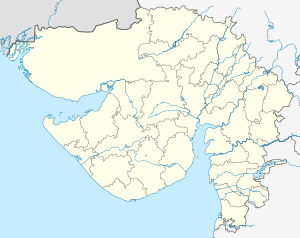| Achut Bibi's Mosque and Tomb | |
|---|---|
 Achut Bibi's Mosque, 1862 | |
| Religion | |
| Affiliation | Islam |
| Status | Active |
| Location | |
| Location | Dudheshwar, Ahmedabad |
| Municipality | Ahmedabad Municipal Corporation |
| State | Gujarat |
| Geographic coordinates | 23°03′20″N 72°34′57″E / 23.055606°N 72.582533°E |
| Architecture | |
| Type | Mosque and tomb |
| Style | Indo-Islamic architecture |
| Funded by | Imad ul Mulk |
| Completed | 1469 |
| Designated as NHL | Monument of National Importance ASI Monument No. N-GJ-24 |
Achut Bibi's Mosque and Tomb, also known as Shahi Masjid locally, is a medieval mosque and tomb complex on the bank of Sabarmati river in Dudheshwar, Ahmedabad, India.
YouTube Encyclopedic
-
1/1Views:850 043
-
Tipu Sultan End ( Final Battle of the Tiger of Mysore )
Transcription
History and architecture


Achut [Achhut] Bibi's mosque was built in 1469 by Haji Malik Bahauddin, entitled Imad ul-Mulk, one of Mahmud Begada's (1459-1511) ministers, for his wife Bibi Achut Kuki whose tomb is close by. Very little is known about Bibi Achut Kuki. Possibly she was an important member of royal harem.[1][2]
The mosque and tomb are enclosed in stone walls. The entrance has two arches and two minarets with Indo-Islamic architecture. Its large enclosure was once adorned by seven minarets, three at the outer and two at the inner entrance, and two on the mosque itself. Except the lower parts of the mosque minarets, all seven were thrown down and destroyed in the 1819 Rann of Kutch earthquake.[1][2]
The tomb complex of Bibi Achut Kuki is located on the south end of the mosque. It is an open canopy with thirty two pillars and eight domes under which several unmarked tombs are located. The exact tomb of Bibi is not identifiable as flagstones are missing.[1][2] The tomb and mosque was again damaged in 2001 Gujarat earthquake and was restored by Archaeological Survey of India. The structures are also threatened by encroachments.[2][3]
References
- ^ a b c Gazetteer of the Bombay Presidency: Ahmedabad. Government Central Press. 1879. p. 284.
 This article incorporates text from this source, which is in the public domain.
This article incorporates text from this source, which is in the public domain.
- ^ a b c d "Adhesives injected to protect monuments". The Hindu. 19 February 2001. Archived from the original on 11 December 2014. Retrieved 11 December 2014.
- ^ "PEARLS OF PAST: Need Some Elbow Room". The Times of India. 25 November 2011. Archived from the original on 13 December 2014. Retrieved 7 December 2014.


